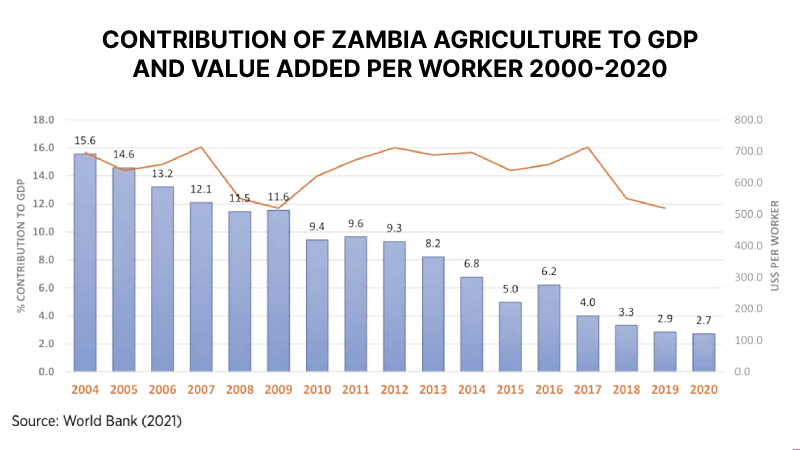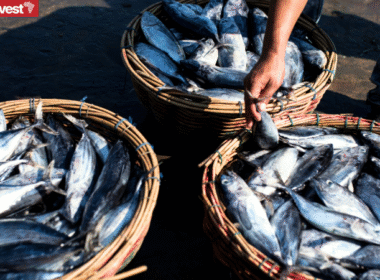Agriculture
 In 2020, Zambia’s agricultural sector contributed 2.7% to the national GDP (USD 18.11 billion at current prices). This was a 2% reduction from its contribution in 2019 (2.9%).
In 2020, Zambia’s agricultural sector contributed 2.7% to the national GDP (USD 18.11 billion at current prices). This was a 2% reduction from its contribution in 2019 (2.9%).
This reduction in agriculture contribution to GDP has been the trend in the past decade, with an average contribution of 6.74%. The contribution in 2020 is the lowest since 2004 (15.6%).
The Zambian agriculture sector comprises crops, livestock, and fisheries.
Zambia covers 75 million hectares (752,000 km2), out of which 58% (42 million hectares) is classified as medium to high potential for agriculture production. However, only 15% of this land is currently under cultivation.
Zambia has ample water resources but has done little to exploit them via investments in irrigation systems, and the majority of farms remain dependent on rain-fed growing cycles.
In the past 10 years, there has been a general upward trend in the percentage of farmers reporting using fertilizer, as well as the rate of fertilizer application.
Use of Fertilizers in Zambia
The average fertilizer use per hectare (Ha) in 2020/2021 increased to 125 Kg/ Ha up from 102.55 Kg/Ha in the previous season across all smallholders.
However, when netting out non-users, the fertilizer application rate among fertilizer users was significantly higher at 197Kg/Ha up from 160.5 Kg/Ha in the previous season.
Zambia’s Crops
The country’s staple crop and most cultivated is corn (maize). Other major crops include: cotton, soybeans, tobacco, groundnuts, paprika, sorghum, wheat, rice, sunflower seeds, coffee, as well as sugar, fruits, other vegetables and flowers.
The fisheries and livestock sector in Zambia has been put in the spotlight in the last few years, and it is marketed as a viable and economically attractive option in diversifying agricultural production
Zambia’s Livestock
The livestock sub-sector produces everything derived from cattle, as well as dairy products, chicken, eggs, pigs, hides and skins.
In 2020, the livestock sector showed moderate growth for cattle (1.86 %), sheep (5.3 %) and goats (0.21%), with only pigs having a decrease of 12.37 percent. This was attributed to the availability of good pasture and browsing vegetation and water points due to sufficient rains.
Zambia’s Fisheries
The fisheries sector generally continued its upward growth in 2020. Aquaculture production went up by an impressive 18.69% and capture fisheries production increased by 3.94%, with continued investment and positive regional trade being attributed to this growth.
Development of Zambia’s Agriculture
The agricultural sector is guided by the National Agricultural Policy 2012-2030 which undergoes periodic reviews to ensure its relevance to the prevailing climatic, social and economic conditions of the country.
The overall vision is to develop a competitive and diversified agricultural sector driven by equitable and sustainable agricultural development.
Also, the Zambian government seeks to promote agriculture as a way to diversify the economy away from an overreliance on copper.
The government is working to develop farm blocks in all the country’s ten provinces for large and medium commercial farming, fish farming, and livestock production. Private equity and other investors are active in this sector.
Last Updated: 29th June 2022














